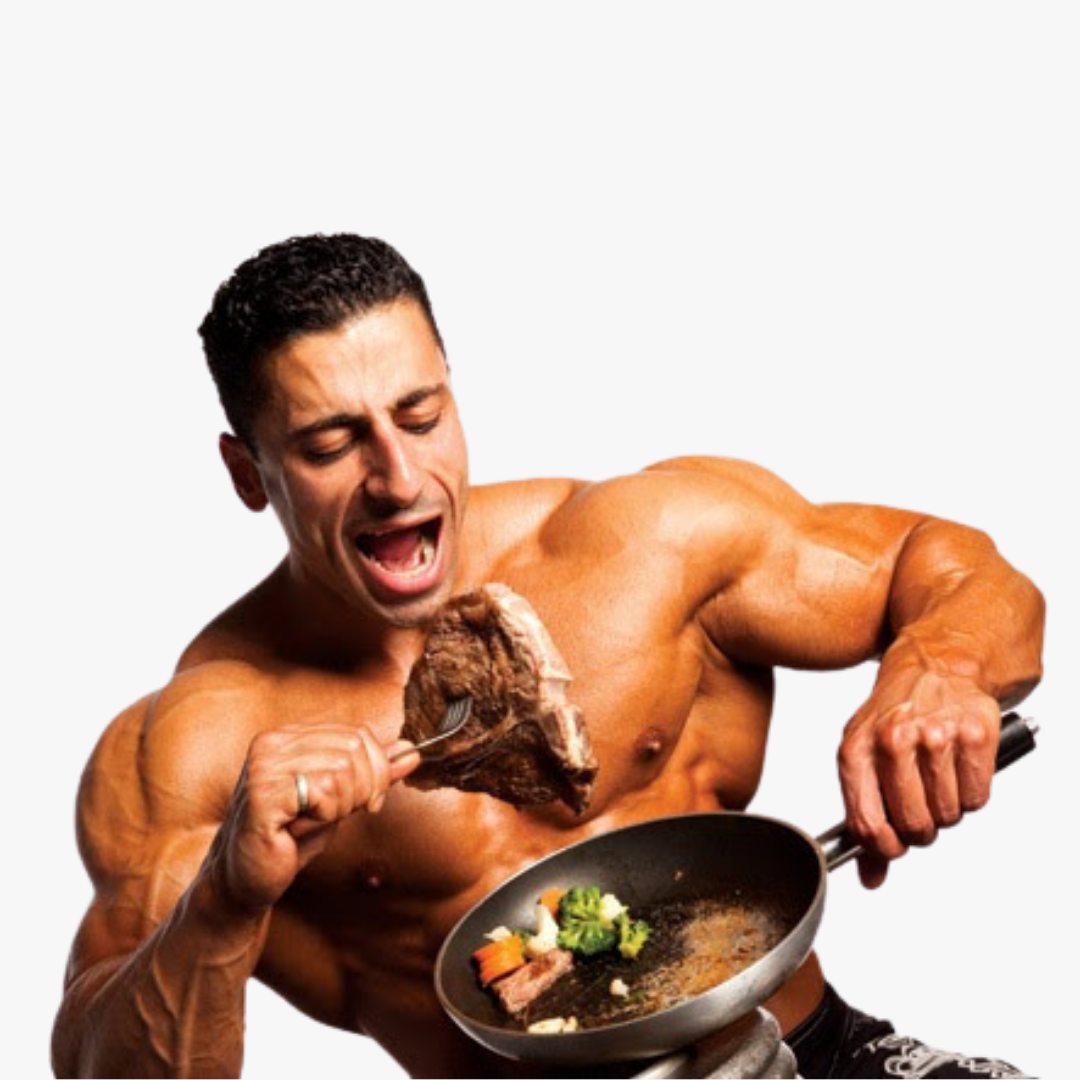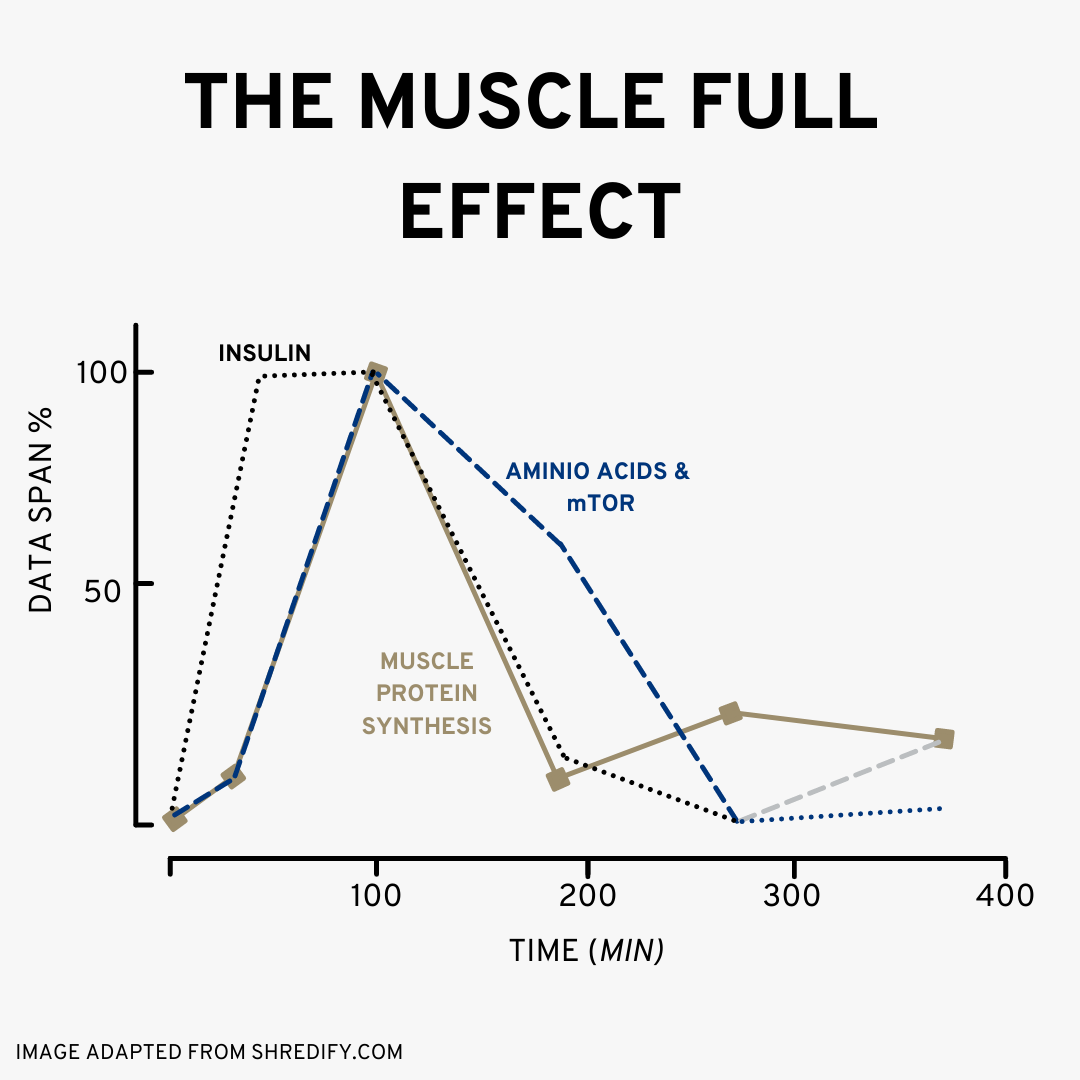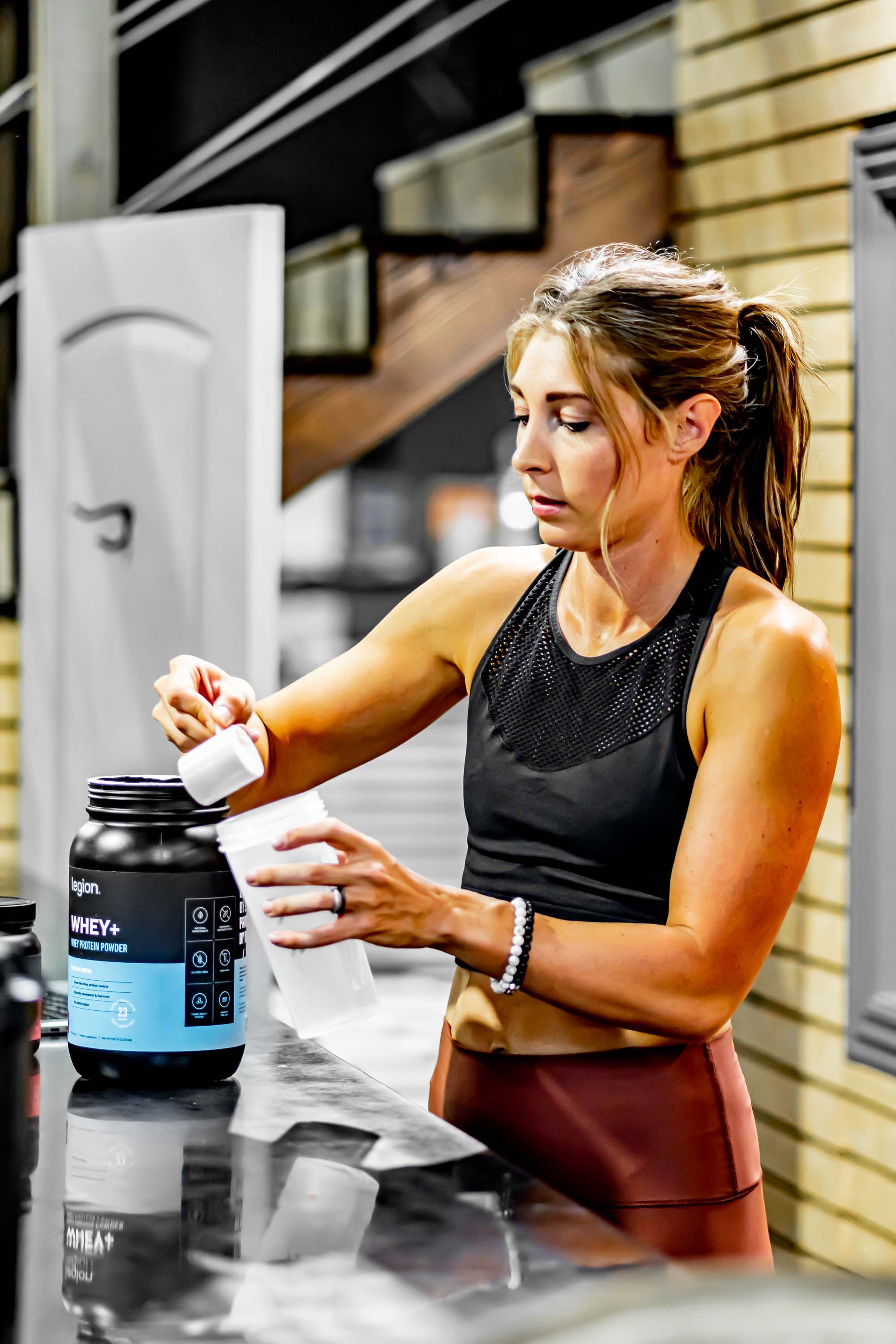If you’ve paid attention to our social media, read our blogs, or are one of our online clients, you know we’re big fans of a high protein intake around here.
Increasing the amount of protein you eat per day up to our recommended amount is the single biggest lever you can pull in transforming your physique.
That’s a pretty bold statement, but if you keep reading, I think you’ll see that I’m backing it up with plenty of supporting points and will agree.
MOST PEOPLE WAY UNDER-CONSUME PROTEIN
When most people think of someone with a high protein diet, they think of a big bodybuilding bro....

On the other hand, when women think of who they want to look like it’s often not the person they’re imagining makes sure they’re getting 4-6 servings of protein throughout the day.

RDA AND AVERAGE AMERICAN DIET
The Recommended Dietary Allowance (RDA) for protein is only 0.8g/kilogram of bodyweight (To find your weight in kilograms, divide your weight in pounds by 2.2)
For a 150 pound person that means the RDA is 54g of protein per day.
That’s insanely low, especially compared to our recommendations (more on those in a bit.)
The average American eats around 100g of protein per day in the context of a calorie intake of over 3600 calories per day.
The average body weight of Americans is 170 lbs (female) to 200 lbs (male), meaning we’re eating roughly 19.5x bodyweight in calories, and .5x bodyweight in grams of protein.
Over 42% of Americans are obese, and 70% are overweight. Of those who aren’t overweight or obese, the Mayo clinic says only 2.7% lives a healthy lifestyle.
If we are taking into account the average American diet or the RDA, I don't think this is the gauge we want to be basing our decisions on.
WHY IS THE RDA SO LOW?
The RDA values are not to optimize your body composition, your performance, your bone health, or your resistance training recovery...they’re to keep you alive. That’s a pretty low bar.
We want to be optimizing our diets and thriving, not just “not dying” from our protein intake.
Our recommendation, based on research, is 0.8-1.2 grams per pound of bodyweight or goal body weight per day.
That means a 150 pound person would bring their protein intake up to 120-180 grams per day. That probably sounds pretty high, and if you haven’t been eating a protein-focused diet it will be a lot higher than your current intake.
You may have heard that eating too much protein is bad for your kidneys, or that eating too much meat is bad for heart health. There’s no evidence that eating a high protein diet has any negative side effects to anyone without a pre-existing kidney condition.
Anyone with impaired kidney function should of-course listen to their doctor’s advice on protein intake.
The issue of meat being a cause for cardiovascular disease is a bit more complicated. The meat is not necessarily the cause for issues so much as an abundance of saturated fat combined with a prolonged calorie surplus.
To minimize saturated fats in your diet, keep things like butter, cured meats, cheese, sausages, and baked goods to a minimum and get most of your protein from non-fat dairy, lean meats, whey, and plant sources.
THE BENEFITS OF HIGH PROTEIN
Keeping your protein intake around 0.8-1.2 grams per pound of bodyweight has a ton of benefits regardless of the phase of dieting you’re in.
1. A HIGHER PROTEIN DIET REDUCES HUNGER, APPETITE, AND CRAVINGS
This is one big reason why we place a big emphasis on keeping protein high throughout a fat loss phase.
In this study obese women took their protein from 15% of total daily calories up to 30% of total daily calories, and ended up consuming 441 calories less per day without intentionally cutting anything.
The researchers concluded this was from the decrease in ghrelin, a hunger hormone.
The same was found in overweight men in this study, where study participants who ate a high protein diet had less cravings and less desire for late-night eating.
2. HIGHER THERMIC EFFECT
Your burns about 25% of calories from protein through digestion which is called the thermic effect of food, or TEF.
The TEF of carbohydrates is about 5-15%, and the TEF of fat is about 0-5%.
It’s a small but still significant difference in calorie output, especially when you also consider all the other positive implications of taking protein up from say 55 grams per day to 150g per day.
That would mean your calories burned from TEF would go up by about 95 calories per day.
3. INCREASES MUSCLE MASS AND STRENGTH, AND HELPS YOU REPAIR AND RECOVER FROM RESISTANCE TRAINING
Skeletal muscle is made from the amino acids that make up dietary protein. Some protein you eat needs to be used for other tissues like organs, bones, skin, nails, etc.
If you’re eating bare minimum (close to the RDA), the protein will get used for those things preferentially, which is part of why you’ll need to go above and beyond the minimum protein number in order to use some protein for muscle repair and growth.
These reasons combined means that a high protein diet is good for improving body composition, allowing you to diet on more calories, grow more muscle mass, maintain a higher metabolic rate, and keep bones strong and stave off osteoporosis.
WHY YOU SHOULD CARE ABOUT MUSCLE MASS
You might read all that and think “yeah, but I don’t want to get muscular…”
Even so, here’s why you should care about increasing the amount of muscle mass on your frame:
BETTER QUALITY OF LIFE
First, more muscle often means more strength. We’re thinking about health, longevity, and quality of life, not just aesthetics.
Being stronger means:
-You can live independently to an older age
-You can lift your own bag into the overhead bin
-You will have less likelihood of falling, and if you do you’ll have less likelihood of breaking a bone.
BETTER HEALTH
Muscle means more carbs without negative health outcomes.
Think of your muscles as a big storage vessel for carbohydrates. The more muscle you have, the more carbs can be stored without overflowing that vessel.
That means more carbs get stored as glycogen to be used as energy rather than floating around as circulating blood glucose or being stored as body fat.
“TONED” PHYSIQUE
Muscle mass with a relatively low body fat percentage is what results in looking “toned.”
Most of the time when someone says they’re too bulky it’s actually from having more body fat than they’d need for the look they want.
The shape you want is a result of having muscle mass, and anyone you’ve looked at as “goals” has probably lifted hard for a few years.
Also, it’s pretty easy to pare muscle down if you ever did end up with too much somehow.
METABOLIC RATE
More muscle means a higher metabolic rate.
Each pound of muscle mass added means you’ll burn a few more calories per day, but the metabolic advantage goes a bit deeper than that.
Training for adding muscle mass sends a muscle-building signal to your body that is metabolically expensive (burns a lot of calories.)
You’ll end up with a more dense body, which is heavier than a body at the same size with less muscle, and a heavier body burns more calories at rest and during activity.
You’ll burn more calories just going through life with more muscle, whereas someone who does only cardio for their exercise will burn more calories during the training session, but less throughout the rest of the day.
PROTEIN SOURCES AND TIMING
In order to get in a large amount of protein per day, you’ll need to have plenty of high-quality sources.
High quality typically means the protein has a complete amino acid profile and plenty of leucine, which is the amino acid that is most responsible for spiking muscle protein synthesis.
These will usually be things like meat, dairy, eggs, fish, and vegan sources like quorn, tofu, or seitan.
Here’s a list of a few favorites:
LEAN PROTEIN
→ Chicken Breast
→ Lean Steak Cuts
→ Fish
→ Turkey Breast
→ Ground Turkey
→ Pork Tenderloin
→ Low-Fat & Non-fat Dairy
→ Egg Whites
→ Protein Powder
FATTY PROTEIN
→ Fatty fish
→ Whole Eggs
→ Fattier Steak Cuts
→ Grass-Fed Beef
You’ll also want to decide on the best protein timing and spacing for you. Here’s a breakdown of how to decide that for yourself, from our blog post Building Muscle For Women
“Muscle protein synthesis (MPS) is the process of repairing and building your muscle tissue and is triggered by a dose of amino acids in your protein, and notably leucine.
This ties into an important concept called "the muscle full effect".
The muscle full effect is the observation that there is a period of time where amino acids spike MPS fully, then there is a necessary period of time where they fall back to baseline before you can maximally stimulate MPS again with another meal.

Because of this you want to spread your protein intake into enough meals to get that MPS spike several times per day, but not spread your protein into such small meals that they don’t contain enough amino acids/leucine to maximize MPS in each.
Typically, 3-6 meals with 3-4 hours between meals will tick both of those boxes.
Exactly what meal spacing you go with in the 3-6 range depends on your total protein amount per day.
A large man eating 250 grams of protein per day is able to have more meals and still hit the leucine threshold... plus he may need to have more meals in order to feel good eating that amount of protein.
250 grams of protein split between 6 meals (40-45 grams per meal) is a lot easier than eating the same amount in two large meals (125 grams of protein per meal).
On the flip side if you are a smaller female weighing around 110 pounds and you split your protein into 6 meals that only gives you about 18 grams per meal, which isn’t enough to maximally stimulate MPS.
We have found that for most clients with a wide range of protein intakes, between 4-5 meals per day seems to be a sweet spot that works well for protein spacing and lifestyle.
Let’s take our example 150 pound woman eating 150 grams of protein per day. Eating 4 meals per day, she’ll need 35-40 grams of protein per meal.
Another strategy you can use to get every last bit of benefit from your protein intake is to have a slow digesting protein source before bed.
This study found that having a 40g dose of casein protein immediately before sleeping improved recovery from exercise and stimulated muscle protein synthesis.
In order to take advantage of the spike of amino acids while you sleep, you’d want to have a slow digesting protein.
The study participants used casein protein powder supplements, but there are other sources of casein that can work like Greek yogurt and cottage cheese.
We’ve seen a ton of women completely change their physique by following these guidelines and increasing their protein intake.
If you want to know more about how to get a nutrition and training plan customized to you and your own goals and lifestyle, so that you can finally stop spinning your wheels and achieve the body (and confidence) you've always wanted - click here to schedule a free call with us. We know you are just as capable as all our other amazing clients of making an incredible transformation and we’d love to talk to you!

written for you by andrea rodgers
Andrea Rogers is a certified nutrition coach, personal trainer, and coach for BairFit. Follow her on Instagram for more helpful training & nutrition content.
Keep Learning

Food Quality Vs. If It Fits Your MacrosProject type

How To Set (And Adjust) Your Macros For Any GoalProject type

The Glute Growth Blueprint [Feat. Alex Bush]Project type

The Ultimate Guide To Flexible DietingProject type

The Fat Loss GuideProject type

How To Fix Stalled Fat LossProject type

The Best Diet To Lose Weight Postpartum - backupProject type

How To End A Diet (Without Losing Your Results)Project type

The Best Diet To Lose Weight PostpartumProject type

The 5 Keys To Maintaining Weight Loss ForeverProject type

How To Use Nutrition Periodization For Fat LossProject type

5 Ways To Get (and stay) MotivatedProject type

The Best Exercises For Building GlutesProject type

How To Hit Your Macros While TravelingProject type

The 6 Keys To Building Muscle For WomenProject type

Mom Of Five Photoshoot Prep (Nutrition Protocol, Training Strategy, Macro Adjustments, And More)Project type

Why Your Macros Aren't Working For Fat LossProject type

The Best Nutrition Strategy For Building MuscleProject type

Should You Bulk Or Cut First?Project type

Mom Of Five Photoshoot Prep (Nutrition Protocol, Training Strategy, Macro Adjustments, And More) - backupProject type

How To Sleep For Muscle Growth & Fat LossProject type

The Stubborn Muscle Solution For Your Delts, Quads, Hamstrings, and Back (Finally See Growth!)Project type

[GUIDE] The Best Diet To Get Lean In 12 WeeksProject type

Thyroid Health 101Project type

How To Change Your Body Fat Set PointProject type

The Core Training BlueprintProject type

How To Minimize Hunger On A DietProject type

Do You Need To Reverse Diet? [When/Why/How]Project type

The Ultimate Guide To PowerbuildingProject type

[GUIDE] How To Do Your First Pull-UpProject type

Building The Female PhysiqueProject type

Nutrition For Aesthetics [Beyond The Basics]Project type

The Definitive Guide To Periodizing NutritionProject type

The Ultimate Mini Cut Guide [Rapid Fat Loss]Project type

[Peak Week Guide] How To Get Photoshoot ReadyProject type

The Rapid Fat Loss ProtocolProject type

The 6 Worst Nutrition Mistakes You're MakingProject type

The Shoulder Training BlueprintProject type

Diet Breaks 101 (What/Why/How)Project type

CALORIE CYCLING 101: 6 Methods To Get You LeanerProject type

HORMONES: Are They Killing Your Results?Project type

The Complete Guide To Getting Visible AbsProject type

The P3 Fat Loss MethodProject type

How To Fix Your Gut Health & DigestionProject type

[Client Case Study] Achieving Lifestyle LeanProject type

How To Find Your Ideal DietProject type

Is Insulin Making You Fat?Project type

Why Fat Loss Stalls [And What To Do]Project type

The Complete Guide To Training At HomeProject type

The Body Composition Change BlueprintProject type

The 6 Most Helpful Things I've Learned In The Last Year [Training, Nutrition, & Coaching]Project type

[Program Design Masterclass] The Full Body SplitProject type

[GUIDE] How To Avoid Holiday Fat GainProject type

Do You Need To Reverse Diet?Project type

How To Stay Lean While Traveling/On VacationProject type

Client Case Study: 6 Months To Photoshoot LeanProject type

[GUIDE] Beat The Skinny-Fat PhysiqueProject type

[10 TIPS] How To Stay Lean For LifeProject type

[KEY TO CLIENT SUCCESS] The Motivation ManualProject type

[GUIDE] The Core Training BlueprintProject type

Fat Loss For Women: The Complete GuideProject type

How To Get Bigger ArmsProject type

Strategies To Make Dieting Suck LessProject type

Dealing With Fat Loss StallsProject type

Compound Exercises vs. Isolation ExercisesProject type

Are Any Supplements Worth The Cost?Project type

7 Diet & Nutrition Tips For Fitness And HealthProject type

Is The Fitness Industry Full of Lies?Project type

The Lean Gains BlueprintProject type

My 3 Favorite Movements For Each Muscle GroupProject type

Can You Grow Your Calves or Is It All Genetics?Project type

The BEST Diet For Rapid Weight LossProject type

Does Eating Red Meat Cause Cancer?Project type

EVERYTHING You've Heard About Fat Loss Is A LIE.Project type

Is It Harder For Women To Get Abs?Project type

How To Get Toned ArmsProject type

How Often Should I Go To The Gym?Project type

How To Prioritize Cardio Vs. WeightliftingProject type

Does Gut Health Effect Weight Loss?Project type

Are Group Fitness Classes Effective?Project type

A Beginner's Guide To Intermittent FastingProject type

Can't Do A Chin-Up? Do This FirstProject type

Best Exercises For Defined ShouldersProject type

Fix Your Back PainProject type

Why can't I gain more muscleProject type

How to build great bicepsProject type

How to get AbsProject type

How to end a diet (without losing your results)Project type

The Best Diet To Lose Weight PostpartumProject type

The 5 Keys To Maintaining Weight Loss ForeverProject type




























































































